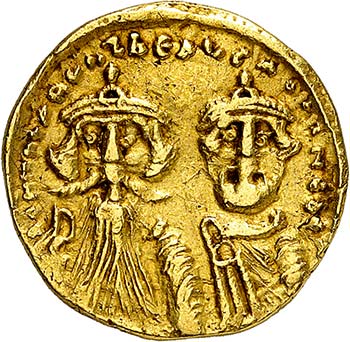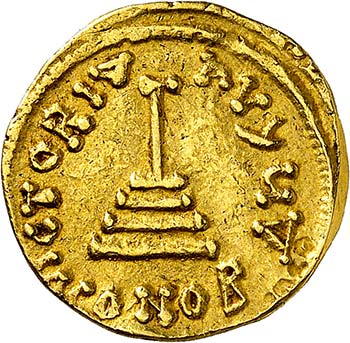- Home
- Auction 12
- 158 Umayyad Dynasty - Pseudo-Byzantine coinage, temp. Caliph ...
Lot 158 - Auction 12
Bids
Description
Grading/Status: An extraordinary rarity of the early Umayyad coinage. Good very fine.
The Byzantine solidus was the gold coin in universal use throughout the eastern Roman world. After the collapse of Byzantine rule in Syria the need for locally produced gold coinage prompted the caliph Mu’awiya to strike his own gold coinage. Several de-Christianized types (without Christian symbols) were produced, copied from the Byzantine coinage of the Emperors Phocas and Heraclius. They are the earliest gold coinage of Islam and witness the development of an original culture and iconography. On this coin, unique and unpublished with the officina letter A, the Christian crosses have been removed from obverse headdresses and the reverse cross was transformed as a pole. These imitations, are well documented by the late George Miles, curator of Islamic coins in the American Numismatic Society, whose book is still the standard authority on this series. It is likely that the extreme rarity of this coin is a result of having been withdrawn from circulation because it offended both the Byzantines and the Muslims, especially after the creation of the first purely Islamic gold coin, the Dinar in AH 77.
Please use the registration form to send us your participation request, or, if you are already registered and authorized, use the login box on the top.
For any information please contact auction@ngsa.ch
Auction 12
Categories
Auction: Auction 12
- Ancient Egypt
- Celtic Coins
- Greek World
- Roman Republic
- Roman Empire
- Byzantine Empire
- Central Asia
- The Islamic World
- Renaissance Medals - collection Alain Moatti
- Renaissance Medals - collection APW
- South Africa
- Albania
- Germany
- Annam/Vietnam
- Armenia
- Austria / Holy Roman Empire
- Belgium
- Bolivia
- Brazil
- Bulgaria
- Cambodia
- Chile
- China
- Colombia
- Comoros
- Croatia
- Cuba
- Denmark
- Egypt
- United Arab Emirates
- Ecuador
- Spain
- Ethiopia
- France
- French provincial coins
- French colonial coins
- Finland
- Great Britain
- British colonial coins
- Greece
- Guatemala
- Guinée Labé (Fouta Djalon)
- Haiti
- Hawaii
- Honduras
- Hungary
- India
- Indonesia
- Iran
- Ireland
- Italy
- Japan
- Latvia
- Lebanon
- Liechtenstein
- Madagascar
- Malta
- Morocco
- Mexico
- Monaco
- Montenegro
- Norway
- New Guinea
- Oman
- Netherlands
- Austrian Nederlands
- Philippines
- Poland
- Puerto Rico
- Portugal
- Romania
- Russia
- Republic of San Marino
- Serbia
- Sweden
- Switzerland
- Czechoslovakia
- Czechia
- Thailand
- Transylvania
- Tunisia
- Uruguay
- USA
- Yugoslavia
Timetable
Pre-bidding - End
17 11 2019 20:00 CET
Room auction - Start
18 11 2019 15:00 CET
Contacts
Rond-point de Plainpalais 1, Ginevra, Genève, Switzerland
 Respecting your privacy is our priority
Respecting your privacy is our priority
This site uses cookies to improve user experience and to collect information on the use of the site. You can read our cookie policy, accept all cookies and continue browsing by clicking on "Accept" or customize your choice by clicking on "Customize".
Cookie Policy
Cookies
To make this site work properly, we sometimes install small data files called "cookies " on your device. Most of the big sites do the same.
What are cookies?
A cookie is a small text file that websites save on your computer or mobile device while you visit them. Thanks to cookies, the site remembers your actions and preferences (for example login, language, font size and other display settings) so that you do not have to re-enter them when you return to the site or browse from one page to another.
How do we use cookies?
Third party cookies
Google Analytics
This site uses Google Analytics to collect information about the use of users of its website. Google Analytics generates statistical and other information through cookies, stored on users' computers. The information generated relating to our website is used to make reports on the use of websites. Googl
How to control and modify cookies?
You can modify or withdraw your consent at any time from the cookie declaration on our website.
Privacy Policy
Find out more about who we are, how you can contact us and how we process personal data in our privacy policy .
The necessary cookies help to make the website usable by enabling basic functions such as page navigation and access to protected areas of the site. The website cannot function properly without these cookies.
| Name | Supplier | Purpose | Expiry |
|---|---|---|---|
| cookieConsent | Bid Inside | Stores the user's cookie consent status for the current domain | 6 months |
| PHPSESSID | Bid Inside | Preserve the user's status in the different pages of the site. | When the browsing session ends |
| f_display | Bid Inside | The f_display cookies memorize the display mode chosen by the user in the pages where there are lists | When the browsing session ends |
| f_page | Bid Inside | The f_page cookies store the page viewed by the user in the pages where there are lists | When the browsing session ends |
| f_rec_page | Bid Inside | The f_rec_page cookies store the number of elements to be displayed per page chosen by the user in the pages in which there are lists | When the browsing session ends |
| f_order_by | Bid Inside | The f_order_by cookies store the sorting parameter selected by the user in the pages where there are lists | When the browsing session ends |
| f_order_dir | Bid Inside | The f_order_dir cookies store the ordering direction chosen by the user in the pages where there are lists | When the browsing session ends |
| watch_list_show_imgs | Bid Inside | The watch_list_show_imgs cookie stores the user's choice to show or hide lot images on the watch list page | When the browsing session ends |
| selected_voice | Bid Inside | The selected_voice cookie stores the voice selected by the user for the speech synthesis present in the live auction | 1 Month |
| include_autobids | Bid Inside | The include_autobids cookie stores the user's choice to show or hide their auto-bids on the 'Your bids' page | 6 months |
Analytical cookies help to understand how visitors interact with the website, collecting and transmitting statistical information to the Data Controller.
| Name | Supplier | Purpose | Expiry |
|---|---|---|---|
| _ga | Register a unique ID used to generate statistical data on how the visitor uses the website. | 2 years | |
| _gat_gtag | Used by Google Analytics to limit the frequency of requests | 1 day | |
| _gat | Used by Google Analytics to limit the frequency of requests | 1 day | |
| _gid | Register a unique ID used to generate statistical data on how the visitor uses the website. | 1 day | |
| __utma | Bid Inside | Used to distinguish users and sessions. The cookie is created when the javascript library executes and no existing __utma cookies exists. The cookie is updated every time data is sent to Google Analytics. | 2 years |
| __utmt | Bid Inside | Used to throttle request rate. | 10 minutes |
| __utmb | Bid Inside | Used to determine new sessions/visits. The cookie is created when the javascript library executes and no existing __utmb cookies exists. The cookie is updated every time data is sent to Google Analytics. | 30 minutes |
| __utmc | Bid Inside | Not used in ga.js. Set for interoperability with urchin.js. Historically, this cookie operated in conjunction with the __utmb cookie to determine whether the user was in a new session/visit. | When the browsing session ends |
| __utmz | Bid Inside | Stores the traffic source or campaign that explains how the user reached your site. The cookie is created when the javascript library executes and is updated every time data is sent to Google Analytics. | 6 months |
| __utmv | Bid Inside | Used to store visitor-level custom variable data. This cookie is created when a developer uses the _setCustomVar method with a visitor level custom variable. This cookie was also used for the deprecated _setVar method. The cookie is updated every time data is sent to Google Analytics. | 2 years |
Preference technical cookies allow a website to remember information that affects the way the site behaves or presents itself, such as your preferred language or the region you are in.
We do not use cookies of this type.Profiling cookies are used for marketing purposes, to monitor website visitors. The intent is to display relevant and engaging ads for the individual user.
We do not use cookies of this type.Unclassified cookies are cookies that are being classified, together with individual cookie providers.
We do not use cookies of this type.





 159
159